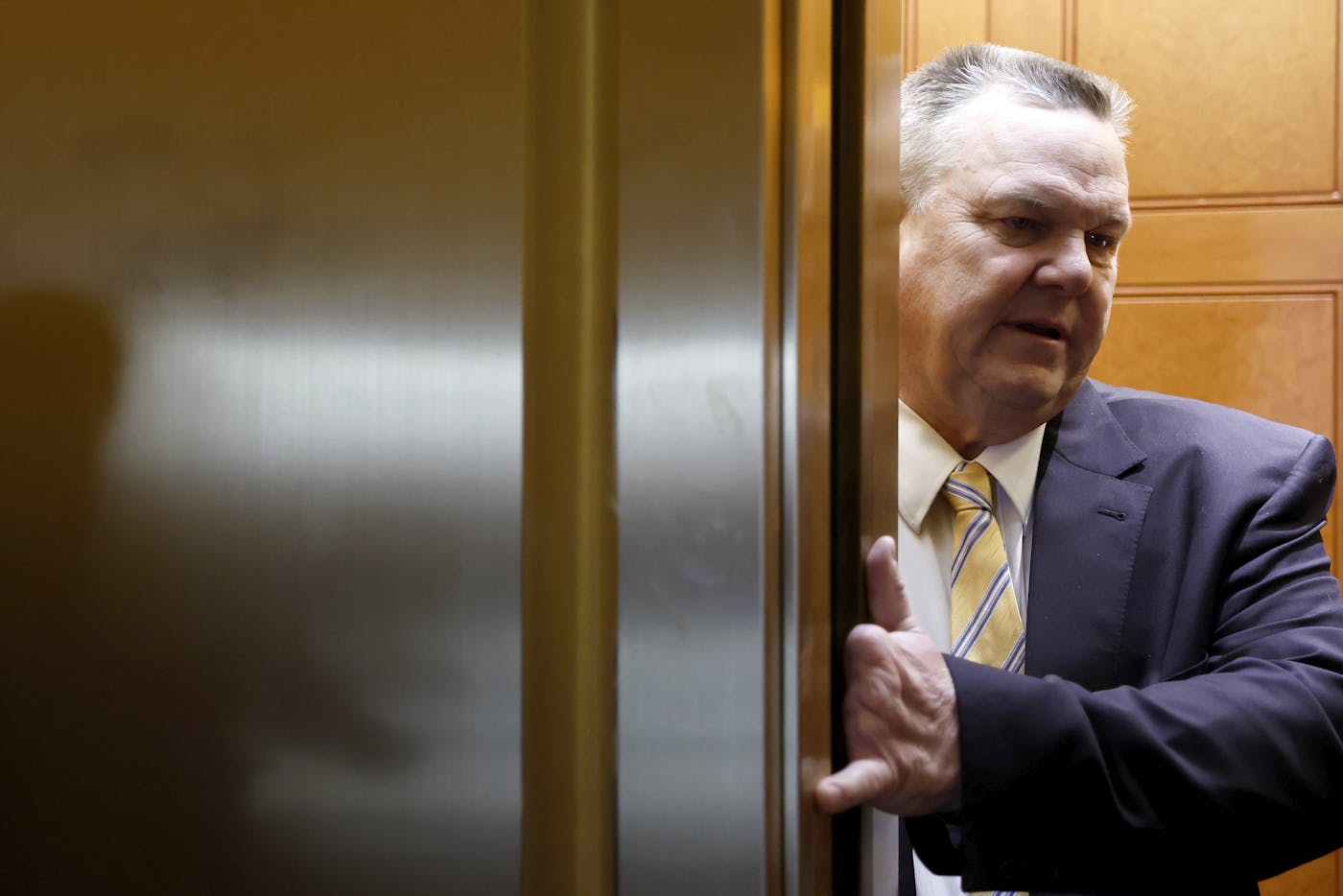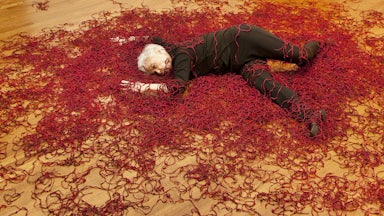By the time Monica Tranel, the Democratic candidate for Montana’s 1st congressional district, arrived at the Philipsburg Fire Volunteer Department, the event was in full swing. A long line of cars was parked along the dirt road leading to the fundraiser, which featured live music and chili. Attendees sat at fold-out tables inside the fire hall or gathered outside in the parking lot, holding cups of locally brewed beer as they chatted under the strengthening April sun.
Tranel, who came within striking distance of defeating Republican Ryan Zinke when she first ran for the seat in 2022, approached potential voters with a drink in her hand and a smile on her face. Philipsburg is a nineteenth-century mining town nestled among the mountains between Butte and Missoula. It is staunchly Republican. Two years ago, Zinke won the surrounding county with 64 percent of the vote; Donald Trump won it with 67 percent in 2020.
Although she is running as a Democrat, Tranel told attendees, she was first and foremost a Montanan: shorthand to let residents know she was, more than anything, one of them. She aimed to maintain a local focus in a conversation with a mustachioed local business owner in P-Burg, as residents call it. They talked about how coal mine closures had affected the local economy and expressed mutual frustration with increased private ownership of public lands. The biggest political issue in the state is arguably the upheaval—and the rising cost of living—caused by rapid population growth. But Tranel wasn’t trying to connect with recent arrivals—she wanted to make an impression on the native Montanans.
“I’m really trying to convey to people that I know this district,” Tranel explained to me later. “I know the people who live here, and I know what the issues are right now.… I know what’s causing hurt, and I know where people are wanting solutions to be advanced.”
But Tranel’s local focus would not necessarily be enough to sway the man’s vote. He told me that he consumed national political talk radio regularly, trying to hear both sides. He listened to what liberal media outlets were saying until it made him want, he said, to “puke in my mouth.” Engagement with national media only entrenched his stance that his conservative beliefs were the right side of America’s political divide. He appreciated that Tranel had visited, he said—as Tranel later told me, showing up where Zinke did not might sway voters in her favor—but he still didn’t believe he could vote for her. They just disagreed on too much.
Aided in part by the decimation of Montana’s local newspapers, the state’s politics have become ever more focused on national issues, to the benefit of Republicans. The GOP has simply done a better job than the Democrats of tying rivals to their party’s national platform, said Tammi Fisher, a former mayor of Kalispell, a town in conservative Flathead County. At the same time, the type of moderate “Blue Dog” Democrats that Montanans have long preferred are a dying breed.
“The greater Montana population doesn’t know who a Blue Dog Democrat is anymore because they’re afraid—‘Is that Nancy Pelosi in sheep’s clothing?’” Fisher explained.
Of course, moderate Republicans are also nearly extinct as well. Bruce Tutvedt, a business-oriented Republican who previously represented Kalispell in the state legislature, described the current political leanings of his former district as “red meat, rabid, red, red, raw.” That trend is playing out statewide: During its 2023 session, the Montana legislature focused on several issues that have dominated right-wing media, such as barring gender-affirming care for minors and banning drag queens from reading to children in public libraries.
“It used to be that local and state issues mattered a lot more, so you could have Democrats in Montana carve out their unique personal brand that was sufficiently detached from the impressions that people have of the national party,” said Robert Saldin, a political science professor at the University of Montana. “That’s just a lot harder now than it used to be, because in the minds of voters, state and local considerations just don’t register as high as they once did.” In November, Democrats across the state—especially Democrat Jon Tester, arguably the most vulnerable senator up for election—will try to turn back the clock, putting local issues at the center while their opponents talk endlessly about the culture war.
Montana’s rapid transformation isn’t just affecting its congressional race—it bleeds into every part of the state’s politics.
Sitting in a conference room at his office on the third floor of the Gallatin County courthouse in Bozeman, Zach Brown looked out the window at the downtown corridor of his hometown. Although Brown is only in his mid-thirties, Bozeman has transformed dramatically in his lifetime.
“The pace of change that we are experiencing here is beyond what most people can cope with emotionally,” Brown, one of Gallatin’s county commissioners, mused. “That’s a big part of my job: receiving frustration, fear, anger around that—around development.”
In 1990, the year that Brown was born, Bozeman had a population of around 22,000 residents. In 2022, more than 56,000 people lived in the city. Gallatin’s population increased more than any other county’s in the state between 2010 and 2022, thanks in part to Bozeman’s Montana State University, a burgeoning tech sector, and the increased popularity of Big Sky, a nearby resort town that acts as an economic engine for the area. Gallatin County has also gotten slightly more Democratic over that period, with Tranel outperforming Joe Biden’s 2020 margin of victory in 2022.
Montana as a whole grew rapidly in 2021 and 2022, largely due to migration from other states, although that growth slowed in 2023. With over a million residents—roughly half of whom were born elsewhere in the country—the state is relatively small, the forty-third-largest by population in the country. As such, a net increase of roughly 16,000 residents from elsewhere, as occurred in 2022, feels significant. Bozeman residents who never previously experienced traffic are now distraught at having to wait through a stoplight during rush hour.
Montana’s unofficial motto is the “last best place.” It is continually being rediscovered—the 1990s had the Montana-based movie A River Runs Through It—but this transformation feels different for many in the state. If rhetoric denouncing out-of-staters isn’t new, it has never been so aggressive, thanks to a skyrocketing cost of living.
“The resentment and the rhetoric is really out of grief, and around a sadness for a changing place,” said Kiersten Iwai, the executive director of Forward Montana, a progressive grassroots organization that aims to engage young voters.
Montanans generally point to two factors accelerating the population growth in recent years: The national popularity of Kevin Costner’s TV show, Yellowstone, which debuted in 2018, attracted viewers with its magnificent scenery and cowboy ethos. The state has also become a popular destination for the rich, who build second or third homes, particularly in the scenic western regions.
“I don’t think there’s a person in Montana who hasn’t felt both the direct and indirect impacts of population growth,” said state Representative Zooey Zephyr, who represents Missoula, Montana’s second-largest city.
Between 2020 and 2022, as working from home became more common, many people moved to Montana, particularly from nearby states with higher taxes. Newcomers who moved to the state during the pandemic are generally viewed with more suspicion, as their jobs may not be directly invested in the local community. These worries translate into larger concern about rising housing costs and skyrocketing property taxes.
In 2023, the average Montana property owner paid 21 percent more in taxes than they did the previous year, following a biannual statewide reappraisal. A recent report by the financial analysis company Bankrate found that Montana had the largest increase in annual income needed to afford a typical home since the onset of the pandemic: a jump of nearly 78 percent since the beginning of 2020. Homebuyers need to earn more than $130,000 a year to afford the state’s average monthly mortgage payment, and the median home price has jumped more than $200,000 since 2020. Meanwhile, the median household income in Montana is just over $67,000.
Mallory Phillips, a co-founder of Shelter WF, a housing advocacy organization in the city of Whitefish in Flathead County, noted that the influx of people into Whitefish had pushed more locals into nearby Kalispell and Columbia Falls, which in turn raised housing prices in those towns. “It just made it really hard for people making local wages to compete,” Phillips said.
Because Montana does not have party registration—voters who participate in a primary are given ballots for all parties, and may vote on one party’s ballots—it’s difficult to know whether more Republicans or Democrats are moving into the state. Some recent movers may have been drawn by Montana’s more laissez-faire approach to addressing the pandemic, as the state quickly dispensed with mask mandates and business closures.
Many of the people who moved to escape their home state’s coronavirus regulations—so-called pandemic refugees—are more ideologically aligned with the state’s dominant Republican Party. But the influx of new residents from those states has left a blurred picture of who is actually moving to Montana.
“The California mythology is deep here,” said Brown. “If you ask people[, they’ll say], ‘They’re Californicating Montana.’ Well, that doesn’t mean anything to me, because in Kalispell, all the people that move there are expat conservatives fleeing liberal politics and wanting less taxes.”
Flathead County, where Kalispell is located, has seen the second-highest rate of population growth between 2010 and 2022, lagging only behind Gallatin. The area has a staunch libertarian streak and has long been a haven for conservatives. It’s a pattern that Chuck Baldwin, the pastor of Liberty Fellowship in Kalispell, has witnessed firsthand. Baldwin himself migrated from Florida to Montana in 2010, and is ideologically aligned with the “American Redoubt,” a movement that aims to establish a haven for conservative Christians in northwestern states like Montana, Idaho, Wyoming, eastern Oregon, and eastern Washington.
Baldwin—who left his position as chaplain of the far-right anti-government group the Oath Keepers in 2020 because it followed federal coronavirus guidelines—said in an interview that he believed Montana attracted conservatives because of its lax gun laws and identity as a “freedom-loving state.”
“They really do want a place where they can be free. They want a place where they are away from the dictatorial governmental policies of these progressive, liberal big cities and states,” he argued.
Montana might be changing, but its politics remain rooted in the state’s strong sense of identity. During commercial breaks of a new episode of NCIS one evening in April, residents of Kalispell were treated to back-to-back campaign ads from incumbent Senator Jon Tester—the sole remaining statewide Democratic elected official in Montana—and Republican candidate Tim Sheehy. The Tester ad hammered Sheehy, a Minnesota native-cum-Navy SEAL-cum-millionaire business owner and recent Montana transplant, as an out-of-touch out-of-stater. “Rich out-of-staters are changing Montana,” the text of the ad warned, blaming Sheehy and his ilk for “rising housing costs and property taxes.”

This is not the first time Tester, who owns a family farm in central Montana, has tried to capitalize on his credentials as a born-and-bred Montanan against a candidate he portrays as a carpetbagger. In 2018, Tester narrowly defeated Republican Matt Rosendale, now a U.S. representative, who is originally from Maryland. Tester’s GOP opponent in 2012, Denny Rehberg, was a lifelong Montanan, but Democrats scathingly cast him as a “mansion rancher,” arguing that his wealth made him an inauthentic vessel for Montana values.
The out-of-stater allegations may not hold the same cultural cachet in the modern era. Montana’s current governor, Republican Greg Gianforte, is a multimillionaire originally from California. Tester squeaked by Rosendale in 2018—but Trump will be at the top of the ticket in November, likely spurring turnout from his loyalists. In an intensely polarized time, Sheehy’s state of origin may be less important than the “R” next to his name. The influx of new residents, moreover, may be more aligned with Republicans. “We’ve seen a lot of people moving to Montana from the COWs—California, Oregon, and Washington,” the state’s Republican senator, Steve Daines, said. “Recent election results, as well as our own data, shows that these new Montanans are largely refugees, not missionaries. They are fleeing repressive policies in blue states in favor of freedom and better leadership in Montana.”
Still, Sheehy’s thin political résumé could be a liability— as could questions surrounding his claim to have sustained a gunshot wound while serving in the military. (Sheehy said he was wounded in Afghanistan, but also admitted to accidentally shooting himself in a national park—a story he now denies.) Democrats have further cast Sheehy as a “rhinestone cowboy,” functionally playing dress-up as a ranch owner. Sheehy’s ranch only allows for private hunting, a flash point in a state where public land access is considered a right.
Some right-leaning Montanans are irked by Sheehy’s sudden elevation as candidate, arguing that he has been plucked out of obscurity and thrust into the national spotlight. Sheehy’s bid earned immediate institutional support from the National Republican Senatorial Committee and its chair, Daines. Flathead County Republican Party chair Al Olszewski, who supported Rosendale in his brief, abortive bid for the Republican nomination for Senate this year, questioned why national Republicans would wish to nominate another candidate from out of state.
“People say out of passion—I hope it’s only out of passion—they say, ‘Well, hell, I’m just voting for Tester. I’m so angry, I’m going to do the opposite of what our Republican senator wants us to do. If he’s cramming this unknown candidate down our throats, I’ll show him. I’m gonna vote for Tester,’” Olszewski said.
Even if it is only a small universe of people who could be swayed to vote—or not to vote—based on whether a candidate was born in Montana, that could still be significant for Tester’s prospects. If support for Sheehy is even slightly weakened by concerns about his authenticity, it could once again help to swing the election toward Tester.
Fisher said that her vote is not given, but “earned.” Although she is no fan of Tester, she is affronted by what she sees as Sheehy’s entitlement. “How can you be so arrogant as to think you can represent my interests when I’ve lived here my entire life, and you’ve been here 10 minutes?” she asked.
She believes she is not alone in this sentiment, feeling that others are dedicated to what she sees as Montana values—that unique combination of respect for privacy and unfailing neighborliness—even before partisan interests. “Our allegiance first is to Montana, because she has been so good to us. It’s always Montana first,” Fisher continued. “Montana comes before party. Montana comes before virtually everything. Because we owe it to her.”




